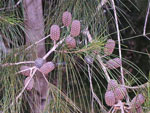
Black Oak (Allocasuarina littoralis)Small narrow tree between 6m and 15m high; bark persistent, rough, hard, dark grey/dark brown. Download the fact sheet (PDF 1.4MB) | 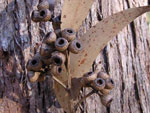
Blackbutt (Eucalyptus pilularis)A tall tree with an open wide crown of green foliage, grows to around 30m in HSC, trunk has a thick stocking of permanent bark often spreading to the first lower limbs, upper branches smooth and pale in colour. Download the fact sheet (PDF 684kb) | 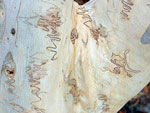
Broad-leaved Scribbly Gum (Eucalyptus haemastoma)A small to medium sized tree with a relatively open crown of grey/silver coloured foliage, often grows with multiple trunks, grows toaround 15m in HSC, trunk is smooth barked and white in colour. Download the fact sheet (PDF 1.9MB) | 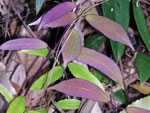
Coachwood (Ceratopetalum apetalum)Tree to 15 m+ high; bark is grey to light grey in colour frequently with fine longitudinal coloured ridges of bark aroundthe stem/trunk. Download the fact sheet (PDF 1.9MB) | 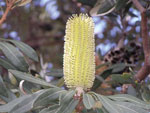
Coast Banksia (Banksia integrifolia)Tree to 10m high in HSC; bark rough – coarsely tessellated and grey to brown in colour. Download the fact sheet (PDF 1.3MB) |
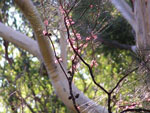
Forest Oak (Allocasuarina torulosa)Tree to 15m+ high; bark persistent, rough, corky, grey/dark brown. Download the fact sheet (PDF 2.3MB) | 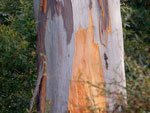
Grey Gum (Eucalyptus punctata)A medium-tall tree with a domed canopy up to 12m in height with a spread up to 8m. Magnificent feature specimen with a broad, open canopy on a single trunk which is an ideal tree for avenue planting. Download the fact sheet (PDF 1.6MB) | 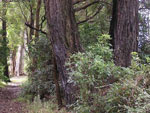
Grey Ironbark (Eucalyptus paniculata)A medium sized to tall tree with an open crown of grey/green like foliage, grows to around 25m in HSC, trunk has heavy rough persistent furrowed bark to the smooth smaller branches. Download the fact sheet (PDF 2.4MB) | 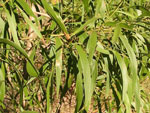
Hickory Wattle (Acacia implexa)Tree to 10m high or more with a bushy crown has very dark coloured and rough bark. Download the fact sheet (PDF 1.9MB) | 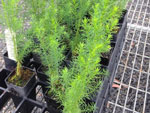
Illawarra Cypress Pine (Callitris muelleri)Small conifer type tree to 6m. Grey persistent bark, evergreen foliage, nice columnar shape. Slow growing but long lived. Very hardy once established. Download the fact sheet? |
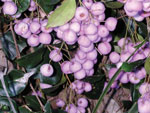
Lillypilly (Acmena smithii)A medium sized tree, up to 8 - 10m, with attractive foliage with fluffy white flowers in summer. These flowers are followed by pink fruits which are edible. Download the fact sheet (PDF 1.2MB) | 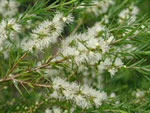
Melaleuca Revolution Green (Melaleuca bracteata var. ‘Revolution Green’)A useful small tree, growing to 6m, cultivated widely for its compact shape, numerous small, cream coloured 'bottle brush' flowers and its ability to grow in a variety of conditions. Download the fact sheet (PDF 184kb) | 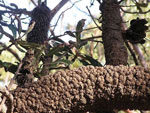
Old Man Banksia (Banksia serrata)Tree to 12m high in HSC; bark rough, very thick, warty and grey to brown in colour. Download the fact sheet (PDF 1.7MB) | 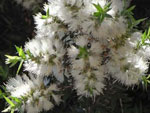
Prickly Leaved Paperbark (Melaleuca styphelioides)Tree to 15 m high; A lovely small tree producing a mass of white/creamy flowers in Spring – Summer. The trunk also provides an interesting feature with thick papery bark. Download the fact sheet (PDF 180kb) | 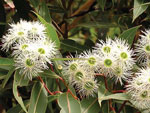
Red Bloodwood (Corymbia gummifera)Medium to tall tree to 25m in HSC; bark is heavy and tessellated/scaly in appearance, dark in colour if subjected to bush fires. Download the fact sheet (PDF 2.8MB) |
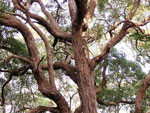
Red Mahogany (Eucalyptus resinifera)A medium sized to tall tree with an open crown of dark green foliage, grows to around 25m in HSC, trunk has thick rough persistent bark to the smaller branches. Download the fact sheet (PDF 1.5MB) | 
Scribbly Gum (Eucalyptus haemastoma)A small to medium-sized tree 12m (h) x 7m (w). Has a beautiful white trunk with intriguing insect-caused scribbles combine with a wonderfully contorted, spreading shape to give a characteristically Australian tree. A great feature tree for street avenues. Download the fact sheet (PDF 1.9MB) | 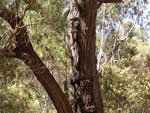
Silver Top Ash (Eucalyptus sieberi)A small to medium sized tree with a bushy crown of grey/silver coloured foliage and strongly noticeable red stems, grows to around 20m in HSC, trunk has a persistent dark black stocking of rough bark extending onto the largest limbs, and smooth pale cream bark shedding in long ribbons. Download the fact sheet (PDF 1.8MB) | 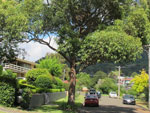
Swamp Mahogany (Eucalyptus robusta)Up to 16m tall. Good fast growing shade tree for coastal situations. The long irregular branches spread laterally, and form a dense canopy with the broad green leaves. Download the fact sheet (PDF 1.4MB) | 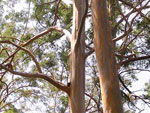
Sydney Blue Gum (Eucalyptus saligna)A tall straight tree to over 35m in HSC, trunk is smooth pale blue-grey to white with a short stocking of persistent bark at the very base. Download the fact sheet (PDF 2.1MB) |
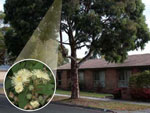
Sydney Red Gum (Angophora costata)Tree to 25m high; bark smooth, pale pink/orange or grey, shed heavily in late spring leaving bright orange new bark exposed. Download the fact sheet (PDF 177kb) | 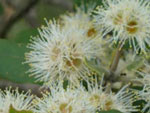
Turpentine (Syncarpia glomulifera)An upright canopy to 16m in height with a spread up to 8m. Magnificent feature specimen with a tall, straight trunk with grey/brown deeply furrowed, stringy bark. The branches tend to grow outwards and then upwards looking like a bent arm. Download the fact sheet (PDF 2MB) | 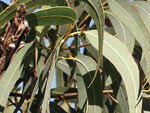
Yellow Bloodwood (Corymbia eximia)A small to medium sized tree, growing to 12m tall, often with a gnarled appearance, bark flaky and yellow in colour. Download the fact sheet (PDF 1.5MB) | | |





























